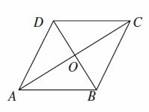Each side of a rhombus is 10 cm long and one of its diagonals measures 16 cm. Find the length of the other diagonal and hence find the area of the rhombus.
Let ABCD be rhombus.

We know that rhombus is type of parallelogram whose all sides are equal.
∴ AB = BC = CD = DA = 10 cm
Let the diagonals AC and BD intersect each other at O, where AC = 16 cm and let BD = x
We know that the diagonals of a rhombus are perpendicular bisectors of each other.
∴ ∆AOB is a right angle triangle, in which OB = BD ÷ 2 = x ÷ 2 and OA = AC ÷2 = 16 ÷ 2 = 8 cm.
Now, AB= OA2 + OB2…by pythagoras theorem
∴ 102 = ( ![]() )2 + 82
)2 + 82
ie. 100 − 64 = 
36 ×4 = x2
∴ x2 =144
∴ x = 12 cm
Hence, the length of the other diagonal is 12 cm
We know that area of rhombus is,
Area of rhombus = ![]() × ( Diagonal1) × ( Diagonal2)
× ( Diagonal1) × ( Diagonal2)
Hence,
Area of ABCD = ![]() × AC × BD
× AC × BD
= ![]() × 16 × 12
× 16 × 12
= 96 cm2
Hence, the area of rhombus is 96 cm2